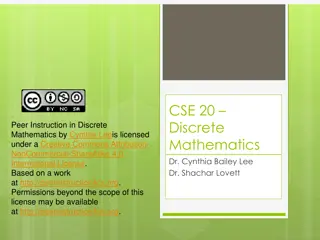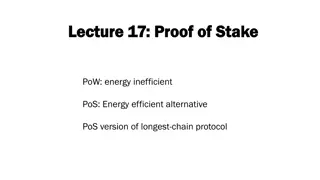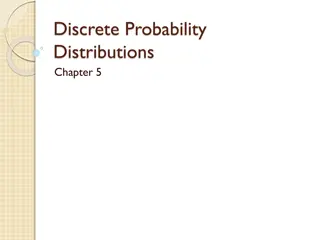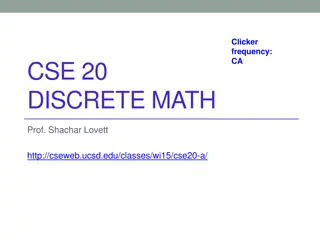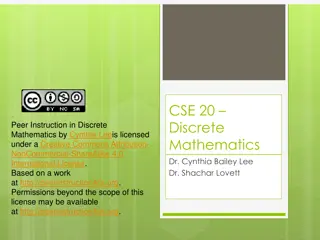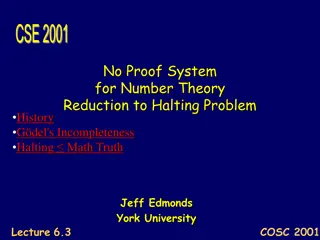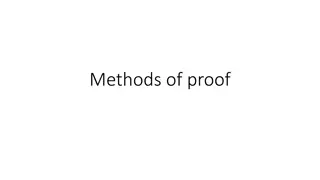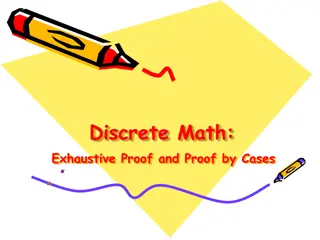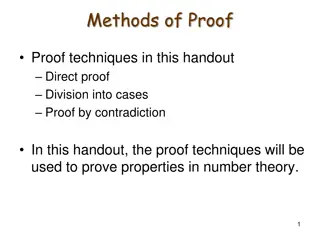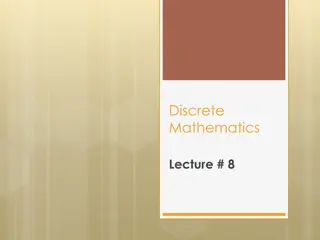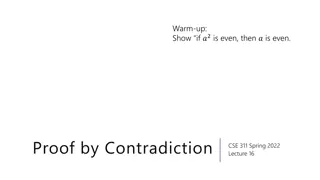Discrete Mathematics: Proof by Cases Example
Exploring a proof by cases example in discrete mathematics, focusing on a theorem stating that among any 6 people, there are either 3 who all know each other or 3 who don't know each other. The explanation breaks down the proof step by step, demonstrating case analysis and subcases to logically show the theorem's validity.
Download Presentation

Please find below an Image/Link to download the presentation.
The content on the website is provided AS IS for your information and personal use only. It may not be sold, licensed, or shared on other websites without obtaining consent from the author. Download presentation by click this link. If you encounter any issues during the download, it is possible that the publisher has removed the file from their server.
E N D
Presentation Transcript
Creative Commons License CSE 20 Discrete Mathematics Dr. Cynthia Bailey Lee Dr. Shachar Lovett Peer Instruction in Discrete Mathematics by Cynthia Leeis licensed under a Creative Commons Attribution- NonCommercial-ShareAlike 4.0 International License. Based on a work at http://peerinstruction4cs.org. Permissions beyond the scope of this license may be available at http://peerinstruction4cs.org.
2 Today s Topics: 1. Finish proof by cases 2. A second look at contradictions 3. Proof by contradiction template 4. Practice negating theorems
3 1. Proof by cases
4 Breaking a proof into cases Assume any two people either know each other or not (if A knows B then B knows A) We will prove the following theorem Theorem: among any 6 people, there are 3 who all know each other (a club) OR 3 who don t know each other (strangers)
5 Breaking a proof into cases Theorem: Every collection of 6 people includes a club of 3 people or a group of 3 strangers Proof: The proof is by case analysis. Let x denote one of the 6 people. There are two cases: Case 1: x knows at least 3 of the other 5 people Case 2: x knows at most 2 of the other 5 people Notice it says there are two cases You d better be right there are no more cases! Cases must completely cover possibilities Tip: you don t need to worry about trying to make the cases equal size or scope Sometimes 99% of the possibilities are in one case, and 1% are in the other Whatever makes it easier to do each proof
6 Breaking a proof into cases Theorem: Every collection of 6 people includes a club of 3 people or a group of 3 strangers Case 1: suppose x knows at least 3 other people Cases 1.1: No pair among these 3 people met each other. Then these are a group of 3 strangers. So the theorem holds in this subcase. Case 1.2: Some pair among these people know each other. Then this pair, together with x, form a club of 3 people. So the theorem holds in this subcase. Notice it says: This case splits into two subcases Again, you d better be right there are no more than these two! Subcases must completely cover the possibilites within the case
7 Breaking a proof into cases Theorem: Every collection of 6 people includes a club of 3 people or a group of 3 strangers Case 2: Suppose x knows at most 2 other people. So he doesn t know at least 3 people. Cases 2.1: All pairs among these 3 people met each other. Then these are a club of 3. So the theorem holds in this subcase. Case 2.2:Some pair among these people don t know each other. Then this pair, together with x, form a group of 3 strangers. So the theorem holds in this subcase.
8 Breaking a proof into cases Theorem: Proof: There are two cases to consider Case 1: there are two cases to consider Case 1.1: Verify theorem directly Case 1.2: Verify theorem directly Case 2: there are two cases to consider Case 2.1: Verify theorem directly Case 2.2: Verify theorem directly
9 Perspective: Theorem in language of graphs Graph: diagram which captures relations between pairs of objects Example: objects=people, relation=know each other A,B know each other A,C know each other A,D know each other B,C know each other B,D don t know each other C,D don t know each other A C B D
10 Perspective: Theorem in language of graphs Graph terminology People = vertices Know each other = edge Don t know each other = no edge A,B know each other A,C know each other A,D know each other B,C know each other B,D don t know each other C,D don t know each other A C B D
11 Perspective: Theorem in language of graphs Theorem: Every collection of 6 people includes a club of 3 people or a group of 3 strangers Equivalently Theorem: any graph with 6 vertices either contains a triangle (3 vertices with all edges between them) or an empty triangle (3 vertices with no edges between them) Instance of Ramsey theory
12 2. A second look at contradictions Q: Do you like CSE 20? A: Yes and no...
13 P AND P = Contradiction It is not possible for both P and NOT P to be true This simply should not happen! This is logic, not Shakespeare Here s much to do with hate, but more with love. Why, then, O brawling love! O loving hate! O anything, of nothing first create! O heavy lightness! Serious vanity! Mis-shapen chaos of well-seeming forms! Feather of lead, bright smoke, cold fire, Sick health! Still-waking sleep, that is not what it is! This love feel I, that feel no love in this. [Romeo and Juliet]
14 Contradictions destroy the entire system that contains them Draw the truth table: A. 0,0,0,0 B. 1,1,1,1 C. 0,1,0,1 D. 0,0,1,1 E. None/more/other (p p) (p p) 0 0 0 0 q p q 0 0 0 1 1 0 1 1
15 Contradictions destroy the entire system that contains them (p p) (p p) q p 0 q 0 0 1 Draw the truth table: 0 1 0 1 1 0 0 1 1 1 0 1 Here s the scary part:it doesn t matter what q is! q= All irrational numbers are integers. q= The Beatles were a terrible band. q= Dividing by zero is totally fine! All these can be proved true in a system that contains a contradiction!
16 3. Proof by contradiction template
17 Proof by contradiction template Thm. Proof (by contradiction): Assume not. That is, suppose that [ theorem] (Don t just write (theorem). For example, changes to , use DeMorgan s law if needed, etc.) [write something that leads to a contradiction: [p] so [ p]. But [p], a contradiction ] Conclusion: So the assumed assumption is false and the theorem is true. QED. [write theorem]
18 Example 1 Thm. There is no integer that is both even and odd. Proof (by contradiction) Assume not. That is, suppose A. All integers are both odd and even B. All integers are not even or not odd. C. There is an integer n that is both odd and even. D. There is an integer n that is neither even nor odd. E. Other/none/more than one
19 4. Practice doing negations
20 Be careful about doing negations Theorem: there is no integer that is both even and odd n Z (n E n O) n Z (n E n O) Negation: n Z (n E n O) There is an integer n that is both even and odd
21 Example 1 Thm. There is no integer that is both even and odd. Proof (by contradiction) Assume not. That is, suppose there exists an integer n that is both even and odd. Try by yourself first
22 Example 1 Thm. There is no integer that is both even and odd. Proof (by contradiction) Assume not. That is, suppose there exists an integer n that is both even and odd. Since n is even n=2a for an integer a. Since n is odd n=2b+1 for an integer b. So 2a=2b+1. Subtracting, 2(a-b)=1. So a-b=1/2 but this is impossible for integers a,b. A contradiction. Conclusion: The assumed assumption is false and the theorem is true. QED.
23 Example 2 A number x is rational if x=a/b for integers a,b. E.g. 3=3/1, 1/2, -3/4, 0=0/1 A number is irrational if it is not rational E.g (proved in textbook) 2 Theorem: If x2 is irrational then x is irrational.
24 Example 2 Theorem: If x2 is irrational then x is irrational. Proof: by contradiction. Assume that A. There exists x where both x,x2 are rational B. There exists x where both x,x2 are irrational C. There exists x where x is rational and x2 irrational D. There exists x where x is irrational and x2 rational E. None/other/more than one
25 Example 2 Theorem: If x2 is irrational then x is irrational. Proof: by contradiction. Assume that there exists x where x is rational and x2 irrational. Try by yourself first
26 Example 2 Theorem: If x2 is irrational then x is irrational. Proof: by contradiction. Assume that there exists x where x is rational and x2 irrational. Since x is rational x=a/b where a,b are integers. But then x2=a2/b2. Both a2,b2 are also integers and hence x2 is rational. A contracition.
27 Example 3 Theorem: is irrational Proof (by contradiction). + 2 3 THIS ONE IS MORE TRICKY. TRY BY YOURSELF FIRST IN GROUPS.
28 Example 3 + Theorem: is irrational Proof (by contradiction). Assume not. Then there exist integers a,b such that / 3 2 a b = + 2 3 b = + 2 2 = + + 2 2 2 Squaring gives So also is rational since 6 / ( 2 3) 6 3 a = 2 2 2 6 ( 5 ) / 2 . a b b [So, to finish the proof it is sufficient to show that is irrational. ] 6
29 Example 3 Theorem: is irrational Proof (by contradiction). is rational is rational. 2 3 + + 2 3 6 =c/d for positive integers c,d. Assume that d is minimal such that c/d= Squaring gives c2/d2=6. So c2=6d2 must be divisible by 2. Which means c is divisible by 2. Which means c2 is divisible by 4. But 6 is not divisible by 4, so d2 must be divisible by 2. Which means d is divisible by 2. So both c,d are divisible by 2. Which means that (c/2) and (d/2) are both integers, and (c/2) / (d/2) = Contradiction to the minimality of d. 6 6 6




